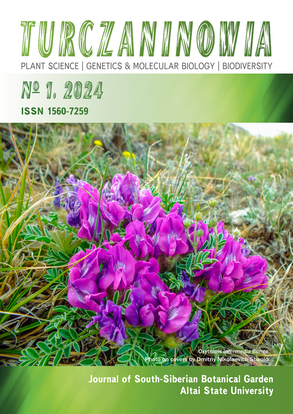Lectotypification and comments on the taxonomic status of Taraxacum pobedimovae Schischk. (Asteraceae: Crepidinae)
UDC 582.998.4:581.92
Abstract
Taraxacum pobedimovae Schischk. was previously considered a synonym of T. hybernum Steven. The type of the former species consists of several plants mounted on a single specimen, which were found to belong to two different taxa: typical T. hybernum and the species previously referred to as the pinkish-achened form of T. hybernum. The lectotype of T. pobedimovae corresponding to the pinkish-achened form is designated. Taraxacum pobedimovae differs from T. hybernum by pinkish (not brown) achenes which are longer and with narrower spinules in comparison with those of the latter species. In addition, T. pobedimovae usually has larger and more numerous leaves with prominently purple veins, longer scapes, and larger capitula, as well as a larger and more branched root. The differences between these two species were confirmed by RAPD, ISSR, and SSR markers as well. The length of the achene beak, previously reported as the diagnostic character, is not useful to distinguish T. pobedimovae from T. hybernum.
Downloads
Metrics
References
Christenhusz M. J. M., Byng J. W. 2016. The number of known plants species in the world and its annual increase. Phytotaxa 261(3): 201–217. DOI: 10.11646/phytotaxa.261.3.1
Efimov P. G., Trávníček B. 2022. Preliminary checklist of the genus Taraxacum (Asteraceae) in North-West European Russia, with five species new for Russia (Taraxacum Notulae Rossiae Boreali Europeae I). Novosti Sist. Vyssh. Rast. 53: 109–124. DOI: 10.31111/novitates/2022.53.109
Филиппов Д. И., Ничипорович А. А., Аксельрод Д. М. (ред.). Культура каучуконосов в СССР. М.: ОГИЗ – Сельхозгиз, 1948. 359 с.
Kirschner J., Oplaat C., Verhoeven K. J. F., Zeisek V., Uhlemann I., Trávníček B., Räsänen J., Wilschut R. A., Štěpánek J. 2016. Identification of oligoclonal agamospermous microspecies: taxonomic specialists versus microsatellites. Preslia 88: 1–17.
Kirschner J., Štěpánek J. 1996. Modes of speciation and evolution of sections in Taraxacum. Folia Geobot. Phytotaxa 31(3): 415–426. DOI: 10.1007/BF02815386
Kirschner J., Štěpánek J., Buryy V. V., Chernyagina O. A., Efimov P. G. 2022a. A new species of Taraxacum sect. Arctica (Asteraceae, Crepidinae) from northern Kamchatka, Russia, with a synoptic survey and a nomenclator of the section in Russia. Phytotaxa 550(2): 171–185. DOI: 10.11646/phytotaxa.550.2.6
Kirschner J., Štěpánek J., Greuter W. 2007+ (continuously updated). Taraxacum. In: Compositae. Eds. W. Greuter, E. von Raab-Straube. Euro+Med Plantbase – the information resource for Euro-Mediterranean plant diversity. URL: https://europlusmed.org/ (Accessed 31 December 2022).
Kirschner J., Stepanova N. Yu., Nosova M. B., Štěpánek J. 2022b. Sexual reproduction in Taraxacum sect. Borealia (Asteraceae, Crepidinae) first documented in the continental Russian Far East. Turczaninowia 25, 2: 155–162. DOI: 10.14258/turczaninowia.25.2.15
Kirschner J., Záveská Drábkova L., Štěpánek J., Uhlemann I. 2015. Towards a better understanding of the Taraxacum evolution (Compositae – Cichorieae) on the basis of nrDNA of sexually reproducing species. Pl. Syst. Evol. 301(4): 1135–1156. DOI: 10.1007/s00606-014-1139-0
Кулуев Б. Р., Фатерыга А. В., Кулуев А. Р., Михайлова Е. В., Чемерис А. В. 2018. Молекулярно-генетическое исследование одуванчика осеннего (Taraxacum hybernum Steven) с использованием SSR, RAPD и ISSR-маркеров // Вавил. журн. генет. и селекции, 2018. Т. 22, № 1. С. 102–107. DOI: 10.18699/VJ18.337
Kuluev B., Fateryga A., Zakharova E., Zakharov V., Chemeris A. 2022. Pinkish-achened form of Taraxacum hybernum Steven – a source of inulin and high molar mass natural rubber. Bot. Lett. 170(2): 258–268. DOI: 10.1080/23818107.2022.2147998
POWO. 2022. Plants of the World Online. Kew: Royal Botanic Gardens. URL: http://www.plantsoftheworldonline.org/ (Accessed 31 December 2022).
Привалова Л. А. Taraxacum Wigg. // Флора Крыма. Т. 3, вып. 3. Под ред. Н. И. Рубцова и Л. А. Приваловой. Ялта: Государственный Никитский ботанический сад, 1969. С. 316–320.
Rewicz A., Marciniuk J., Marciniuk P. 2020. Achene micromorphology and its taxonomic significance in some species in Taraxacum sect. Palustria (Asteraceae). PhytoKeys 166: 1–28. DOI: 10.3897/phytokeys.166.54271
Шишкин Б. К. Taraxacum Wigg. // Флора СССР. Т. 29. Под ред. Е. Г. Боброва и Н. Н. Цвелева. М.; Л.: Наука, 1964. С. 405–560).
Turland N. J., Wiersema J. H., Barrie F. R., Greuter W., Hawksworth D. L., Herendeen P. S., et al. (eds.). 2018. International Code of Nomenclature for algae, fungi, and plants (Shenzhen Code) adopted by the Nineteenth International Botanical Congress Shenzhen, China, July 2017. Regnum Vegetabile 159. Glashütten: Koeltz Botanical Books. DOI: 10.12705/Code.2018
Цвелев Н. Н. Taraxacum Wigg. // Флора европейской части СССР. Т. 8. Под ред. Н. Н. Цвелева. Л.: Наука, 1989. С. 61–114.
Steven Ch. von. 1856. Verzeichniss der auf der taurischen Halbinsel wildwachsenden Pflanzen. Bull. Soc. Imp. Naturalistes Moscou 29(4): 339–418.
Wolanin M., Klichowska E., Jedrzejczyk I., Rewers M., Nobis M. 2023. Taxonomy and distribution of Taraxacum sect. Erythrosperma (Asteraceae) in Poland. PhytoKeys 224: 1–88. DOI: 10.3897/phytokeys.224.99463
Ена А. В. Аннотированный чеклист эндемиков флоры Крыма // Укр. бот. журн., 2001. Т. 58, № 6. С. 667–676.
Turczaninowia is a golden publisher, as we allow self-archiving, but most importantly we are fully transparent about your rights.
Authors may present and discuss their findings ahead of publication: at biological or scientific conferences, on preprint servers, in public databases, and in blogs, wikis, tweets, and other informal communication channels.
Turczaninowia allows authors to deposit manuscripts (currently under review or those for intended submission to Turczaninowia) in non-commercial, pre-print servers such as ArXiv.
Authors who publish with this journal agree to the following terms:
- Authors retain copyright and grant the journal right of first publication with the work simultaneously licensed under a Creative Commons Attribution License that allows others to share the work with an acknowledgement of the work's authorship and initial publication in this journal.
- Authors are able to enter into separate, additional contractual arrangements for the non-exclusive distribution of the journal's published version of the work (e.g., post it to an institutional repository or publish it in a book), with an acknowledgement of its initial publication in this journal.
- Authors are permitted and encouraged to post their work online (e.g., in institutional repositories or on their website) prior to and during the submission process, as it can lead to productive exchanges, as well as earlier and greater citation of published work (See The Effect of Open Access).





